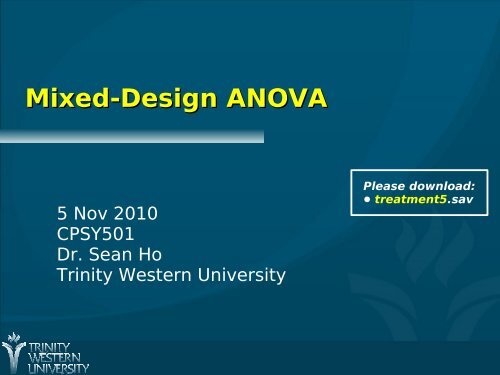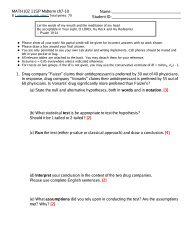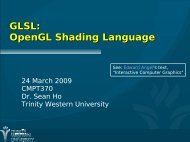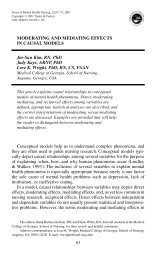Mixed-Design ANOVA
Mixed-Design ANOVA
Mixed-Design ANOVA
Create successful ePaper yourself
Turn your PDF publications into a flip-book with our unique Google optimized e-Paper software.
<strong>Mixed</strong>-<strong>Design</strong> <strong>ANOVA</strong><br />
5 Nov 2010<br />
CPSY501<br />
Dr. Sean Ho<br />
Trinity Western University<br />
Please download:<br />
● treatment5.sav
Outline: <strong>Mixed</strong>-<strong>Design</strong> <strong>ANOVA</strong><br />
<strong>Mixed</strong>-<strong>Design</strong> <strong>ANOVA</strong>: concept, SPSS, output<br />
Interactions: finding significant effects<br />
● Graphing, estimated marginal means<br />
● Using simple effects to aid interpretation<br />
● Extra main effects beyond the interactions<br />
Exploring gender as a moderator<br />
Misc: APA style<br />
Misc: Practise mixed-design <strong>ANOVA</strong><br />
Misc: Covariates: <strong>Mixed</strong>-design ANCOVA<br />
CPSY501: <strong>Mixed</strong>-<strong>Design</strong> <strong>ANOVA</strong> 5 Nov 2010<br />
2
TREATMENT<br />
RESEARCH<br />
DESIGN<br />
Cognitive-<br />
Behavioural<br />
Therapy<br />
Pre-Test Post-Test Follow-up<br />
Factorial<br />
<strong>ANOVA</strong><br />
Church-Based<br />
Support Group<br />
Wait List<br />
control group<br />
Repeated<br />
Measures<br />
<strong>ANOVA</strong><br />
CPSY501: <strong>Mixed</strong>-<strong>Design</strong> <strong>ANOVA</strong> 5 Nov 2010<br />
3
Assumptions of RM <strong>ANOVA</strong><br />
Parametricity: (a) interval-level DV,<br />
(b) normal DV, (c) homogeneity of variances.<br />
● But not independence of scores!<br />
Sphericity: homogeneity of variances of<br />
pairwise differences between levels of the<br />
within-subjects factor<br />
● Test: if Mauchly’s W ≈ 1, we are okay<br />
● If the within-subjects factors has only 2 cells,<br />
then W=1, so no significance test is needed.<br />
CPSY501: <strong>Mixed</strong>-<strong>Design</strong> <strong>ANOVA</strong> 5 Nov 2010<br />
4
Follow-up analysis: post-hoc<br />
If the overall RM <strong>ANOVA</strong> is significant, explore<br />
differences between specific cells/times:<br />
● Analyze → GLM → Repeated Measures:<br />
Define → Options:<br />
● Estimated Marginal Means:<br />
move RM factor to “Display means for”<br />
● Select “Compare Main Effects”, use<br />
“Confidence interval adjust.”: Bonferroni<br />
Plot the effects over time:<br />
● Plots → IV in “Horizontal axis” → Add<br />
● Or try error bar plots<br />
CPSY501: <strong>Mixed</strong>-<strong>Design</strong> <strong>ANOVA</strong> 5 Nov 2010<br />
5
Post hoc comparisons, cont.<br />
Note: the Post-Hoc button applies only to<br />
between-subjects factors<br />
● Hence not applicable here: we only have<br />
one IV (Time) and it is within-subjects<br />
Interpret the output:<br />
● Bonferroni results show that the mean<br />
Pre-test scores are significantly higher than<br />
the mean Post-test & Follow-up scores<br />
● But the Post-test & Follow-up scores are not<br />
significantly different<br />
● (see “Pairwise Comparisons”, “Estimates”)<br />
CPSY501: <strong>Mixed</strong>-<strong>Design</strong> <strong>ANOVA</strong> 5 Nov 2010<br />
6
<strong>Mixed</strong>-<strong>Design</strong> <strong>ANOVA</strong><br />
Advantages: More complete model<br />
● Moderators!<br />
● Treatment effects of interventions:<br />
Treatment groups (between-subjects) X<br />
Time (pre-/post-) (within-subjects)<br />
● Any therapy study would use this!!<br />
Disadvantages: “More work…”<br />
● Tracking, interpreting interactions<br />
● Can we trust complex results?<br />
● May need larger sample sizes<br />
CPSY501: <strong>Mixed</strong>-<strong>Design</strong> <strong>ANOVA</strong> 5 Nov 2010<br />
7
Treatment5 Example<br />
DV: Depressive symptoms<br />
● (healing = decrease in reported symptoms)<br />
IV1: Treatment group (between-subjects)<br />
● CBT: Cognitive-behavioural therapy<br />
● CSG: Church-based support group<br />
● WL: Wait-list control<br />
IV2: Time (pre-, post-, follow-up) (within-subj)<br />
We will now do a full mixed-design study using<br />
both Treatment group and Time<br />
CPSY501: <strong>Mixed</strong>-<strong>Design</strong> <strong>ANOVA</strong> 5 Nov 2010<br />
8
<strong>Mixed</strong>-<strong>Design</strong>: SPSS<br />
Analyze → GLM → Repeated measures → Define:<br />
Add IVs to “Between Subjects Factor(s)”<br />
Options: Effect size, Homogeneity tests, etc.<br />
Check assumptions: Parametricity, sphericity<br />
● Note: sphericity holds for treatment5 if we<br />
include the treatment groups in the design!<br />
CPSY501: <strong>Mixed</strong>-<strong>Design</strong> <strong>ANOVA</strong> 5 Nov 2010<br />
9
Output: <strong>ANOVA</strong> Tables<br />
Output: first purely between-subjects effects<br />
● Then within-subjects effects and<br />
interactions involving within-subjects factors<br />
Main effects and interaction effects:<br />
check F-ratios, significance level, and effect size<br />
● Highest-order significant interactions first<br />
For all significant effects, do follow-up:<br />
● Graph interactions<br />
● Post-hoc cell-by-cell comparisons<br />
● See if main effects have an interpretation<br />
beyond the higher-order interactions<br />
CPSY501: <strong>Mixed</strong>-<strong>Design</strong> <strong>ANOVA</strong> 5 Nov 2010<br />
10
Examining Interactions<br />
Graph significant interactions to understand<br />
● Graphs plot the estimated marginal means<br />
Confirm with the numbers behind the plots:<br />
● Options: Estimated Marginal Means<br />
● Examine confidence intervals<br />
Treatment5: “The interaction of treatment<br />
group by time is significant, F(4, 54) = 7.28,<br />
p < .001, η 2 = .350, demonstrating that …”<br />
CPSY501: <strong>Mixed</strong>-<strong>Design</strong> <strong>ANOVA</strong> 5 Nov 2010<br />
11
CPSY501: <strong>Mixed</strong>-<strong>Design</strong> <strong>ANOVA</strong> 5 Nov 2010<br />
12
Interactions: Simple Effects<br />
Follow-up on significant interaction:<br />
Use simple effects to describe precisely which<br />
treatment groups differ significantly<br />
● E.g., focus on just post-treatment time and<br />
do one-way <strong>ANOVA</strong> with Bonferroni post-hoc<br />
● Confirm with estimated marginal means<br />
The effect here is strong and clear, so even this<br />
conservative strategy shows that both<br />
treatment groups are lower than WL group, at<br />
post-treatment and follow-up times.<br />
CPSY501: <strong>Mixed</strong>-<strong>Design</strong> <strong>ANOVA</strong> 5 Nov 2010<br />
13
Interactions: Interpretation<br />
We found a significant interaction:<br />
● “The interaction of treatment group by time<br />
is significant, F(4, 54) = 7.28, p < .001,<br />
η 2 = .350, demonstrating that …”<br />
Graphing + simple effects + est. marg. means<br />
give us the interpretation of the interaction:<br />
● “…the decrease in symptoms of depression<br />
from pre-test to post-test and follow-up was<br />
greater for the treatment groups than it was<br />
for the WL control group.”<br />
CPSY501: <strong>Mixed</strong>-<strong>Design</strong> <strong>ANOVA</strong> 5 Nov 2010<br />
14
Main Effects with Interactions<br />
Main effects are only meaningful if they tell us<br />
something beyond what the interaction tells us.<br />
In Treatment5, both Treatment and Time main<br />
effects merely reflect the interaction effect.<br />
● Only report the interaction with follow-up<br />
CPSY501: <strong>Mixed</strong>-<strong>Design</strong> <strong>ANOVA</strong> 5 Nov 2010<br />
15
Follow-up for Main Effects<br />
To look for main effects beyond the interaction:<br />
If there are only 2 levels of a repeated measure,<br />
no post-hoc is needed; the main effect is simply<br />
the pairwise difference between the two levels.<br />
If there are more than 2 levels:<br />
For between-subjects factors: “Post Hoc” button<br />
● Select appropriate post-hoc test<br />
For within-subjects factors:<br />
Options: “Compare means”<br />
● Remember to use Bonferroni correction<br />
CPSY501: <strong>Mixed</strong>-<strong>Design</strong> <strong>ANOVA</strong> 5 Nov 2010<br />
16
Treatment5: Interpretation<br />
Last time, we ran a simple RM <strong>ANOVA</strong> on<br />
treatment5 and found a significant main effect<br />
for Time<br />
But that is not the best model to explain the<br />
data, as we found today with <strong>Mixed</strong>-<strong>Design</strong>:<br />
What's really going on is the interaction<br />
between Treatment Group and Time:<br />
● Treatment effect over time<br />
CPSY501: <strong>Mixed</strong>-<strong>Design</strong> <strong>ANOVA</strong> 5 Nov 2010<br />
17
Other Moderators: Gender?<br />
We found a clear treatment effect, but are there<br />
other potential moderators to add to the model?<br />
In counselling psychology, gender often is an<br />
important variable in many analyses<br />
RQ: Do the treatments seem to work<br />
“the same” for both women and men?<br />
● Look for 3-way: Gender * Time * Treatment<br />
● 2-way interaction may also be useful:<br />
Gender * Time or Gender * Treatment<br />
● Main effect for gender not useful here<br />
CPSY501: <strong>Mixed</strong>-<strong>Design</strong> <strong>ANOVA</strong> 5 Nov 2010<br />
18
Gender as Moderator: SPSS<br />
Clean and check assumptions on Gender<br />
● We actually have missing data for gender<br />
Analyze → GLM → Repeated measures → Define:<br />
● “Between Subjects Factor(s)”:<br />
now add both Treatment Group and Gender<br />
Interpret output tables for interactions:<br />
● Remember that SPSS prints<br />
pure between-subjects effects separately<br />
from within-subjects effects and interactions<br />
CPSY501: <strong>Mixed</strong>-<strong>Design</strong> <strong>ANOVA</strong> 5 Nov 2010<br />
19
Output: Gender effects<br />
Between-subjects effects:<br />
● Gender * Group effect is not significant<br />
Within-subjects effects:<br />
● No 3-way interaction<br />
● Time * Gender effect is significant<br />
(21% effect size)<br />
Follow-up on Time * Gender:<br />
● Graph and get estimated marginal means<br />
to try to understand the interaction<br />
CPSY501: <strong>Mixed</strong>-<strong>Design</strong> <strong>ANOVA</strong> 5 Nov 2010<br />
20
Summary: Moderation analysis<br />
Women showed less improvement on average<br />
than did the men,<br />
but that did not depend on treatment group.<br />
So gender moderates response to treatment<br />
(but also to Waitlist!)<br />
● Doesn't change our interpretation of the<br />
treatment effect – it still seems to “fit” both<br />
women and men<br />
● For research publications, this “check”<br />
might not even be reported for the journal.<br />
CPSY501: <strong>Mixed</strong>-<strong>Design</strong> <strong>ANOVA</strong> 5 Nov 2010<br />
21
APA style notes<br />
Provide evidence for your interpretations!<br />
● Explain why you think something is true<br />
and report the statistics …<br />
No space between F and (): “F(2, 332) = …”<br />
R 2 is NOT the same as r 2<br />
Kolmogorov-Smirnov test: “D(105) = …”<br />
Round to 2 decimal places for most stats<br />
● Round to 3 for p and η 2<br />
Italicize Latin letters (p), not Greek letters (η 2 )<br />
CPSY501: <strong>Mixed</strong>-<strong>Design</strong> <strong>ANOVA</strong> 5 Nov 2010<br />
22
Practise: <strong>Mixed</strong> <strong>ANOVA</strong><br />
Treatment5: try a <strong>Mixed</strong> <strong>ANOVA</strong> with:<br />
● Within-subjects: “outcome” and “follow-up”<br />
● Between-subjects: “relationship status”<br />
Check assumptions<br />
Is there a significant interaction effect between<br />
pre/post treatment and relationship status?<br />
● If so, interpret the interaction.<br />
CPSY501: <strong>Mixed</strong>-<strong>Design</strong> <strong>ANOVA</strong> 5 Nov 2010<br />
23
FYI: Covariates in <strong>Mixed</strong>-<strong>Design</strong><br />
ANCOVA + RM + Factorial:<br />
● Enter “Covariates” in GLM → RM dialog<br />
Covariates must remain constant across<br />
all levels of the within-subjects (RM) factor<br />
● “Varying” covariates: enter as second RM IV<br />
in the model (or use multi-level modelling)<br />
Covariates should not be related to predictors<br />
● Should have no significant interactions<br />
● Need for homogeneity of regression slopes<br />
CPSY501: <strong>Mixed</strong>-<strong>Design</strong> <strong>ANOVA</strong> 5 Nov 2010<br />
24

















